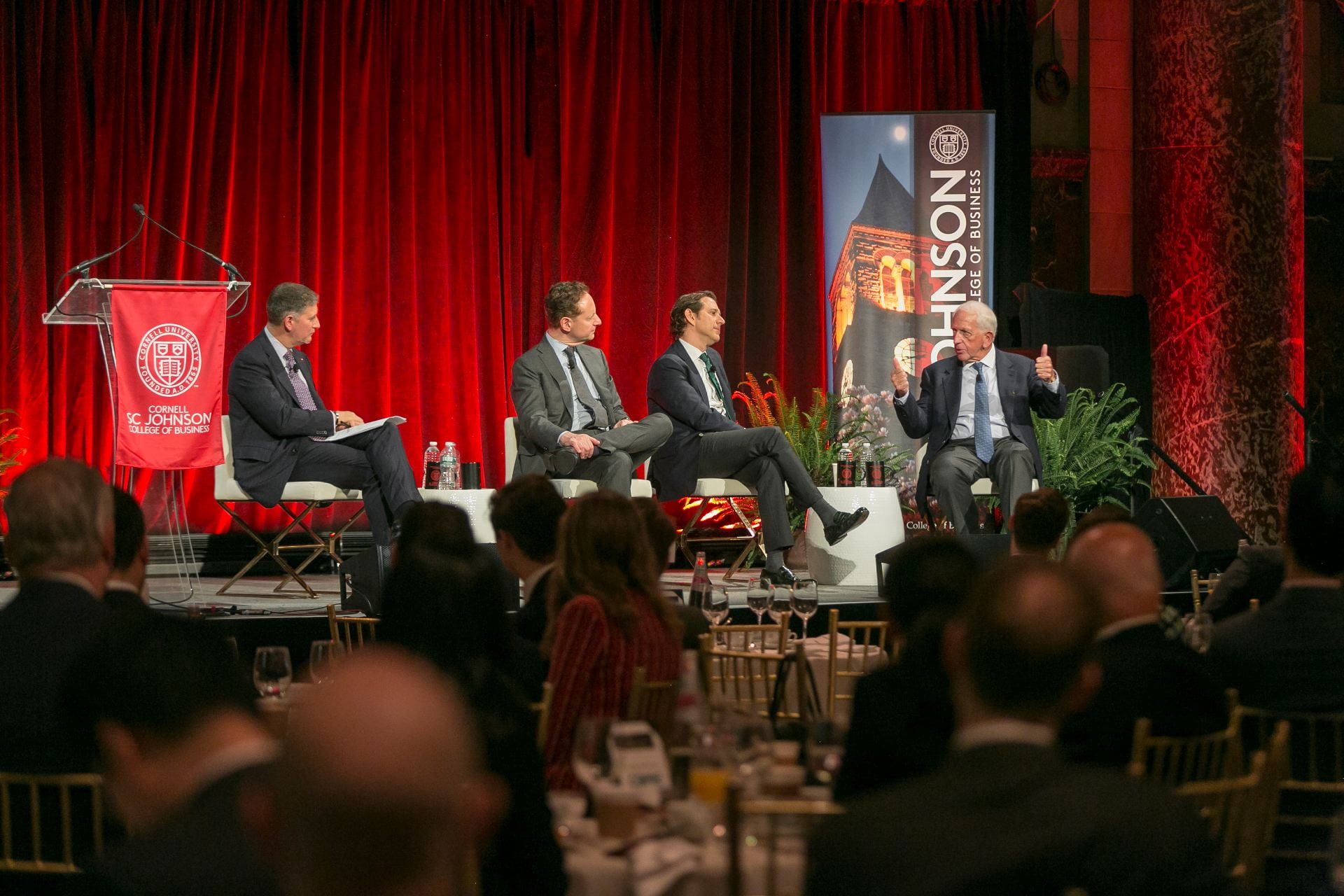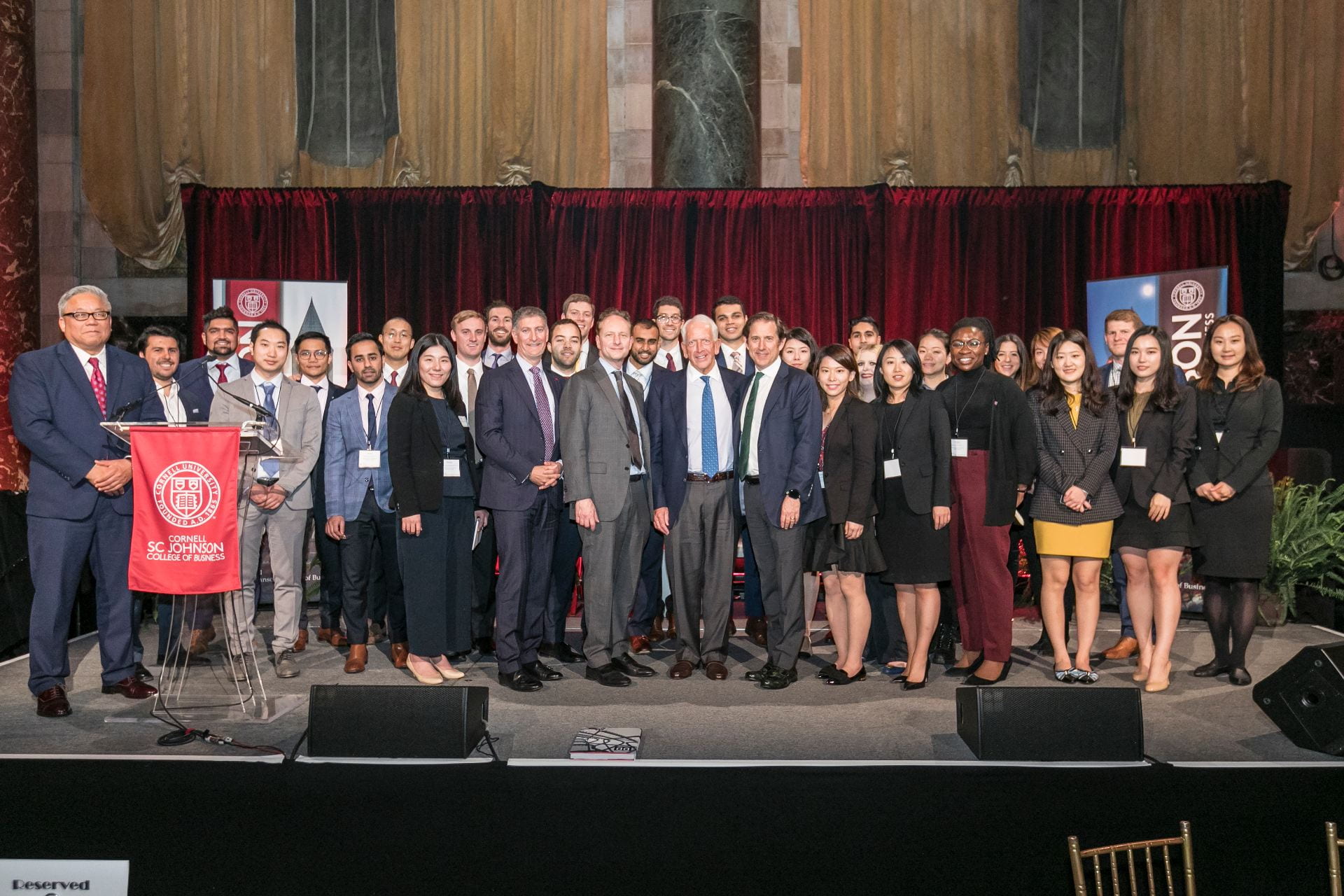
On Friday, April 19, 2019, Cornell University’s Center for Real Estate and Finance and the Baker Program in Real Estate hosted the Fourth Annual Titans of Real Estate at Cipriani 42nd Street in New York City. This year’s panel discussion focused on mixed-use properties and the strategies that real estate firms must employ to successfully position these properties in the rapidly-evolving retail environment. The panel consisted of Richard Baker (SHA ’88), Governor and Executive Chairman of the Hudson’s Bay Company, an owner and operator of retail stores in the United States, Canada, and Europe, including Hudson’s Bay, Lord & Taylor, and Saks Fifth Avenue; Kenneth Himmel (SHA ’70), President and Chief Executive Officer of Related Urban, a developer of large-scale mixed use properties, including Hudson Yards in New York City; and Matt Bronfman, Principal and Chief Executive Officer of Jamestown, L.P., a real estate investment and management company with some of its notable projects being Chelsea Market in New York City and Ponce City Market in Atlanta. The panel was moderated by Marty Burger (P ’17 and ’20), Chief Executive Officer of Silverstein Properties, Inc., a full-service real estate development, investment, and management firm that developed and owns, among other properties, the new World Trade Center in Lower Manhattan.
With retail being a fundamental component of any mixed-use development, the panelists agreed that, to create vibrant and successful mixed-use spaces, developers have to embrace the paradigm shift that is occurring in retail and think differently than developers did in the past. Gone are the days of building a retail complex, leasing it up, and clipping coupons. Now, developers have to continually “surprise and delight people” and focus on “curation,” as Mr. Bronfman remarked, in order to create an “exciting place,” as Mr. Baker commented, that continues to attract people. In order to do so, Mr. Himmel explained that content is key. Drawing from his recent experience with Hudson Yards and his past experiences with successful mixed-use developments like Time Warner Center in New York City and Water Tower Place in Chicago, Mr. Himmel discussed the pitfalls of “commodity” retail environments and emphasized the need for developers to have conviction and absolute attention to detail. With Hudson Yards, Mr. Himmel stated how Related used the best designers, architects, and other professionals in the world to create a truly special environment.
Numerous challenges confront developers, like Related and Jamestown, embracing this new retail paradigm. For instance, lease terms are shorter, rental structures rely more heavily on percentage rent, developers have to invest more money in tenant improvements, and divestment opportunities can be more limited until proof of concept has occurred. In addition, to properly curate a retail experience, developers will sometimes have to choose a tenant that will help create a certain experience as opposed to a tenant that will pay the highest rent, as Jamestown did when putting a book store in Chelsea Market, as Mr. Bronfman explained. Further, companies like Related and Jamestown, as Mr. Himmel and Mr. Bronfman commented, are investing significant dollars into marketing and events teams, which are not in and of themselves profit centers, in order to spread awareness and drive people to their projects. Significant investments in technology are also necessary for landlords to get a fuller sense of how retailers are faring in their projects, as Mr. Bronfman discussed. Further, the halo effect of a successful mixed-use project benefits neighboring properties, and a developer may regret not having made a bigger bet and bought more properties adjacent to its successful mixed-use project, as Mr. Bronfman explained was Jamestown’s experience with Ponce City Market. On the other hand, as Mr. Bronfman recounted, a developer is making a big bet with just a project and investing in additional nearby properties will not look particularly good if the original project does not succeed to the degree expected.
While much of the discussion focused on the retail component of mixed-use developments, the panelists emphasized the importance of the non-retail components of a development in the project’s overall returns. Indeed, Mr. Bronfman recalled how with a project like Chelsea Market, “the money is upstairs” – in other words, Jamestown was able to obtain premium rents for the office space above Chelsea Market because of the desirability of the retail space, which amounted to a relatively small part of the overall project. Mr. Himmel explained how a similar dynamic is at play with Hudson Yards wherein the retail space is an amenity to drive occupancy and “record-breaking rents” at the project’s office and residential components, which make up a far larger percentage of the project.
With the real estate landscape continuing to change, Mr. Bronfman remarked on how Jamestown was starting to look to secondary cities, particularly college towns, that are great cities but do not have particularly interesting real estate, listing Austin as one example. For Mr. Himmel and Related, much of the focus will remain on Hudson Yards, which just recently opened to the public and has enjoyed immediate success with large numbers of daily visitors to the project according to Mr. Himmel (approximately 55,000 on weekdays and over 100,000 people on weekends). Finally, Mr. Baker remains focused on driving customers to his retailers (whether in-store or online) while redeploying any excess real estate in his company’s portfolio, which includes some of the best downtown locations in the world.

